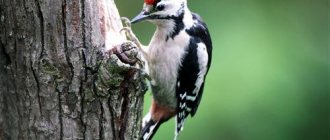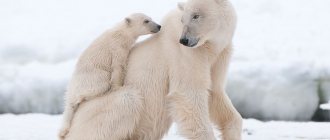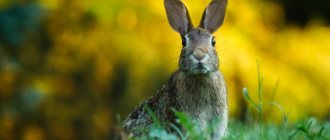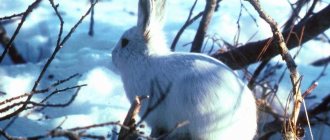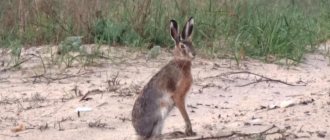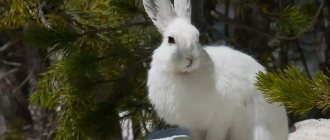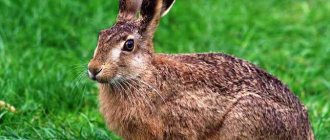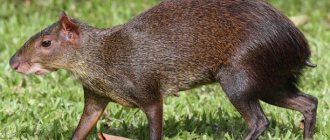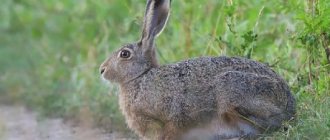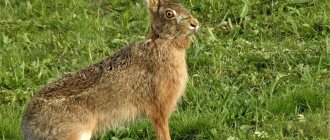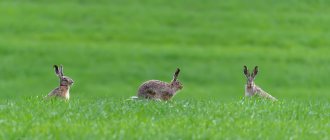The hare is one of the most common and famous animals in Russia. Men go hunting for him, women wear clothes with hare fur, and children watch cartoons and read fairy tales about the jumping bunny. But what exactly is this animal?
In lessons about the surrounding world, schoolchildren get acquainted with various species of this animal, learn the features of appearance by looking at pictures, differences in habits and adaptability to nature and habitat, and learn ways to prepare hares for autumn and winter. Some people, especially in villages, keep rabbits as pets. Information on how to care for animals so that they produce healthy offspring is very important and interesting.
The main species are hare and hare.
Hares have long feet with four clawed toes. However, hunters who do careful research of animal tracks can tell that the soles of the paws are different. While the hare's fingers fan out in all directions, the hare's fingers are more pressed together.
The hare's tail is small and fluffy; depending on the species, it may have a different tip.
Main types
There are only two widely known species - the hare and the hare, but they are not limited to them. Let's briefly talk about some types of hares.
Hare-cuff
It receives special characteristics from both parents equally, just as it can produce offspring from both.
Many believe that this species is fictitious, or very rare.
Tolai hare
Tolai is several times smaller than a hare. It lives mainly in Asian countries where there are deserts and mountains
, therefore its ears and paws are much longer than those of ordinary hares. Tolai does not like traveling and makes them only when absolutely necessary, for example, in search of food.
He does not dig holes himself; he prefers to occupy the abandoned homes of other animals - marmots, foxes or gophers. The color is thick gray, it does not change the color of its coat - and it is not capable of moving in the snow. That is why this species lives in steppe areas.
Arctic hare (Arctic hare)
The Arctic hare is very similar to the hare and was even considered a relative, but today it is considered to be a separate species. It lives in cold places on the planet, such as the tundra, Greenland, Canada.
It has thick fluffy fur and short ears, which allows it to better tolerate cold and accumulate heat.
Arctic hare are not shy and are almost not afraid of people, because they are very well camouflaged in the snow due to the color of their fur.
Brown hare
Rusak is a lover of freedom. He can be found near populated areas, as well as in fields, where he loves to run. Due to this, it looks much slimmer than other types.
You can distinguish a hare by his ears - they are very long, even longer than his head itself.
Its coat color is brown-gray, like a stone, and the coat itself is smooth and silky.
The hare has very good hearing and vision - he notices danger already at a distance of 300 or 400 meters.
You can meet the hare all over Russia. It is more active at night or at dusk, but in a calm environment it can be seen during the day.
White hare
The hare is more conservative and cautious. In winter, it digs holes in the snow and hides in them, feeding on dry grass and bark. It is distinguished by its light weight. Its paws are very short, and therefore it has difficulty moving in the snow.
The hare got its name for its color - in winter it is completely white and blends in with the snow, and by summer it molts and becomes gray, like a hare.
He also leads a nocturnal lifestyle and tries not to go far from his burrows, returning to them periodically. The hare also inhabits most of our country.
What does a hare eat?
Hares are herbivores and prefer to eat leaves and roots. In winter, when there is little vegetation, bark and dried leaves are used. And in the spring, due to a lack of minerals and food, they can eat soil or even stones.
In the summer, they eat various vegetables and fruits. However, despite this, several cases were recorded when hares ate the meat of birds - partridges, which fell into the traps of hunters.
Where do hares live
For most species, the usual habitat is forest. There you can find enough food, hide from danger, and in winter you can bury yourself in the snow and wait out the bad weather.
The white hare can live in forest plantations, hide under fallen trees or in bushes. In summer it can live in dense forests, but in winter it prefers more advantageous places, such as clearings or undergrowth.
The hare can be found not far from one’s own home, in a garden or bush, because he is more humane.
How do hares prepare for winter?
As a rule, before winter, hares begin to become pubescent. Their fur becomes denser and serves to protect them from the cold. The white hare changes color from gray to snow-white.
In very cold weather, they can dig holes in the snow, up to 2 meters deep, and sit there for whole days, waiting out the frosts. And as soon as it gets warmer, the hares run to the open area, to where the first grass appears. Hares do not stock up on food for the winter, pinning their hopes on luck. They can even dig holes in haystacks.
Interesting Facts
There have always been many legends around the hare. One of them is a horned hare - does such an animal exist? This mythical animal appears in many cultures, acquiring either sharp predatory fangs or wings in addition to its horns. There is even a city in the USA that is declared the capital of horned hares. Souvenir licenses for shooting hares are sold there.
Why is the hare called oblique?
In Russian literature this name can often be heard and there is some truth in this. All this is due to its interesting structure of the eyes - they are located on the sides of the head. When a hare runs away from something, it looks sideways and can crash into a tree, and if it looks forward, its eyes converge at its nose, which is very similar to strabismus.
Is the hare a rodent or not?
Many people believe that the hare is a rodent because it constantly gnaws on something, but this is not so. They are distinguished from rodents by the structure of the palate and the presence of two incisors.
Source
Why does a hare need white pants in winter?
A story about a hare. E. Shim. White pants
It’s freezing in the forest, the animals are getting ready to exchange their summer clothes for winter ones. And this is a novelty for the young Bunny. He is just facing his first winter. And the Bunny can’t wait to show off his new look. I didn’t wait until all my clothes were ready, I took them and put on new pants. “Ehma,” he says, “I’ll walk around and show off!” And the pants are really good. White, like the first snowball, fluffy, warm! The Hare is walking, and you can see his new pants far away, as if someone is waving a handkerchief. The Hare rejoices: “Let everyone see, let everyone envy!”
And of course, we saw it. As soon as the Little Hare came out into the clearing, the Owl noticed from the tree. She rushed down, aimed her claws - she’s about to grab it! The Hare barely dodged, ran wildly into the bushes - under a Christmas tree, and under a birch tree...
He jumped out into the birch forest - the fox noticed it from afar. She chased with all her might, even yapping with joy as she ran... The Hare barely forestalled her, circled for an hour until the Fox fell behind.
He flew out to the edge of the forest - and here you are: the Hunter is walking towards him with a gun. Right now, right now, he'll take aim at you!
Oh, if only I could take off my white pants! Don't jump out of them. The Hare hid in the deepest thicket and hid in the bushes behind a hummock. He’s lying there, trembling: as if someone had inadvertently noticed. I now understand that white pants are not given for beauty alone.
After reading, ask your child: “Why is the hare given a white winter coat and white “pants”?
Do you know or know everything about hares.
- hares can be found in any country on earth, as they live all over the globe;
— in the summer heat, hares’ ears help them escape from overheating. They actively remove heat from the body;
- when it rains, hares bend their ears so that water does not get into them and they do not catch a cold;
- Hares can spring on their legs for several kilometers in a row at a speed of 50 kilometers per hour, while making unimaginable turns. You can say that they have real springs in their paws;
- Hares' teeth grow throughout their lives. They wear off when the hares chew food, but they never stop growing;
- Hares are territorial animals. Even when this animal runs away from a hunter or predator, it moves within its territory;
- Many people are mistaken in believing that hares are vegetarians. In fact, these animals eat not only cabbage and carrots, but also meat.
- to communicate between relatives, hares use their “drum roll”, which they beat with their paws. Just like elephants, animals stomp their feet on the ground, warning other animals that the territory is occupied;
Hares are often called cross-eyed, although in fact these animals do not have cross-eyed eyes. And they are called that because of the bunny’s ability to loop while running. In this way, the hare tries to confuse its pursuer and escape the chase. The animal twists and turns all the time also because of its asymmetrically developed left and right legs;
— in winter, the fur on the belly of hares lengthens by a couple of millimeters so that the animal does not freeze its tummy. Hairs also grow around the nose, protecting it from frost;
- there is a known case when a hare was raised by a domestic dog. The animal adopted a behavior pattern from its “teacher”: it rushed at other dogs and even bit them;
- previously, hares were classified as belonging to the order of rodents, but now a separate order of lagomorphs has been allocated for them;
in good weather, when the hare is in danger, he puts his ears vertically, and, clinging to the ground, examines everything around, while remaining unnoticed.
- hares live no more than 9 years, and males even less - about 5. However, cases have been recorded when a hare lived up to 13.5 years.
How does a hare winter: what does a hare eat in winter?
During the day it is dangerous for a hare to run through the forest - he sits in a hole - hiding from everyone. And in the evening he comes out of his hiding place to eat and run around to his heart's content. The hare eats tree branches and the bark of young birches and willows in winter. The hare loves the bitter bark of young aspen trees. Hares have very sharp teeth - like scissors!
The hare's third assistant in winter is his white winter coat. During the day, hares sit under snowy white bushes in a white fur coat, and they are unnoticed. The color of their fur blends with the color of the snow.
You will learn why a hare needs a white coat in winter from an educational fairy tale for children.
Stories about the hare for children
“About the Hare” Author of the story: Iris Review
The hare is an old friend of ours. The ears are long, the tail is not large, the hind legs are strong. The animal belongs to the order of rodents.
In summer the hare is gray, reddish-gray, slate. In winter - white.
“The little gray bunny was jumping under the Christmas tree,” the children sing. In fact, the hare is not such a coward. In nature, this happens: an eagle attacks a hare, but it lies on its back and fights back with all its might with its hind legs.
The hare's habitat is mainly floodplain meadows (located in the river floodplain), sparse forests. The hare has more than enough enemies. Wolves, foxes, birds of prey, he is afraid of them all. But catching up and catching a hare is not easy. His paws are wide and fluffy. For example, in winter. Sometimes he runs like he’s skiing. There are a lot of snowdrifts in winter, nothing for the hare, and dogs cannot overtake him.
In order to hide from winter frosts, the hare digs a hole in the snow. As a rule, it sleeps during the day and comes out to eat at night.
“Cowardly as a hare”, “If you chase two hares, you won’t catch either”, “Hare nature” - this is what people say about the hare.
What do bunnies like to do? Breed offspring. The first babies appear when the snow has not yet melted, the next generation - in the summer, and also in the fall, hares are born.
“Little Bunny” Author of the story: Gennady Snegirev
A little hare sits in a clearing and waits. He is waiting for the hare to run past and feed him milk. The little bunny doesn't know his mother. For him, all bunnies are mothers, because every hare feeds both her own and other people’s bunnies.
Until the little hare grows up, he doesn’t jump through the forest, he doesn’t leave traces, otherwise the fox will find him and eat him.
Small, gray, jump, jump along the path, poke at the snowball. poke. *** White in winter, gray in summer. ***
A smart forest dweller stole a cabbage leaf.
His eyelashes are trembling, is there a fox somewhere?
*** Forests hide many troubles. There's a wolf, a bear and a fox! Our animal lives in anxiety, runs away from trouble... Well, quickly guess, what is the animal's name? ...
Little jumper: Short tail, pigtailed eyes, ears along the back, clothes in two colors - for winter, for summer.
Source
E. Shim. White and hare
- You, Rusak, live in the fields, in wild places. Must run better than me, the forest hare. “I’m already a better runner.” You, Belyak, can’t keep up with me! “Let’s run all the way to that tree.” Who's the fastest? - Let's! ... - Well, Rusak? Did I overtake you? - Overtook... Ufff!.. - That's it! Don’t boast that you can run better than me, the forest hare. The snow in your fields is always strong, the wind blows it, and covers it with infusion. But in our forest the snow is always loose, and in order to run on it, you need to have paws like these! - What are these? - But look: the fingers are spread out, there is fur between the fingers. What's your ski? Where can you, shoeless, keep up with me!
The hare's second assistant in winter is its strong hind legs. It is with them that the hare pushes off the snow, running away from enemies. Invite your child to jump like a bunny - ask: “How do you push off the floor? Are your legs strong? Can you jump far ahead?
It is with its strong hind legs that the hare fights off its enemies if they overtake it. The hare will lie on his back and let's fight off the enemy with his hind legs! And not everyone can grab it!
Tales about hares: truth and fiction
Few can compare with this animal in terms of references in countless fairy tales, short stories, poems, and cartoons. Since childhood, everyone has pitied this timid, fearful, downtrodden creature, who cannot understand how he survives in a world full of horrors and dangers. True, sometimes fairy-tale and cartoon hares demonstrate both cunning and audacity, but this is rather an exception to the rule in the spirit of paradox. And everyone knows that the oblique hare is extremely good-natured and lives somewhere in the forest in a small cozy hole. So, most of the “rabbit” stereotypes are simply slander!
Firstly, hares are far from being the cowards and alarmists they are portrayed to be. They are not inclined to rush into a senseless flight, they do not shy away from every bush and, if the predator is far enough away, they prefer to calmly go about their own business. In the event of an attack, the hare is capable of fiercely defending itself and its offspring: with its powerful hind legs, like a real boxer, it can repel the attack of a fox, dog and even an eagle. Moreover, there are cases when, in the heat of defense, hares with a blow of their paw tore the chest and broke the ribs of uninvited feathered guests. And they themselves are not good-natured vegetarians: in addition to carrots and cabbage (and apple bark in winter), they calmly gobble up meat, they can even attack small birds, and they don’t disdain carrion.
The truth is that if you suddenly lift a hare from its resting place, it will actually rush to run away like crazy - that’s all we’ve seen. But this is not due to any exceptional timidity, it’s just that the hare has an unusually large number of enemies: foxes, wolves, martens, birds of prey, not to mention hunters with dogs. Even crows and magpies occasionally bully. How can you relax here? And strong and amazingly fast spring legs are a sure way to escape from any danger. The hare's reaction is brilliant, he takes off from his spot with the speed of a catapulted cannonball, sometimes rushes in five-meter jumps, reaching speeds of up to 50 km per hour, rolls down steep slopes in a bun, and even confuses his tracks.
It was the puzzling loops and pretzels that the hare manages to twist while running that gave him the reputation of being “oblique.” After all, he won’t settle down to rest without proper preparation: first he will walk back and forth in his own tracks a couple of times, then he will suddenly jump to the side and only after that he will hide. It is clear that these maneuvers have nothing to do with strabismus: it’s just that hares are masterful confusions. But their left and right paws are really located asymmetrically. The eyes are quite even, large, only set very widely, on the sides of the head - so that the horizon is broader. From the outside it may seem that they actually periodically mow somewhere to the side or back.
Another means of protection is long, elongated ears, a real auditory periscope that catches every suspicious rustle. When resting, the hare holds them in an upright position in order to hear danger in time. In addition, the ears are a kind of thermal regulator that saves you from overheating when running fast: thanks to the abundance of capillaries, they emit heat without losing moisture. It is enough to press your ears to your body - that’s precious coolness. In winter, on the contrary, they retain heat. The inconvenience only arises during rain: the ears have to be folded so that water does not get into them and the hare does not catch a cold.
As for the “bunny’s hut,” these animals do not have a permanent home. There is only an understanding of their territory, beyond which hares never run out. They spend the night under the first bush they come across, which seems more or less safe. Even the process of reproduction (and hares, as you know, reproduce very actively) does not imply the creation of a reliable shelter. Despite the fact that up to three or four broods are born in a year: spring hares are called nastoviks (their birthday most often falls at a time when the snow has not yet melted), summer ones are called herbalists or spikelets, and autumn ones are deciduous ones. The rabbits are born quite large, sighted, covered with fur, and after a couple of hours they are able to run. And why waste time? They have an active, restless life ahead of them, which will force them to show their ingenuity and show their courage, and what do people invent about hares - so who cares?
Source
How a hare winters: stories and poems for children
L. Tolstoy. Hares.
At night, forest hares feed on tree bark, field hares on winter crops and grass, and bean hares on grain grains on threshing floors. During the night, hares make a deep, visible trail in the snow. Hares are hunted by people, dogs, wolves, foxes, crows, and eagles. If the hare had walked simply and straightly, then in the morning he would have been found by the trail and caught; but the hare is cowardly, and cowardice saves him.
The hare walks through fields and forests at night without fear and makes straight tracks; but as soon as morning comes, his enemies wake up: the hare begins to hear the barking of dogs, the screeching of sleighs, the voices of men, the crackling of a wolf in the forest, and begins to rush from side to side in fear. He will gallop forward, get scared by something, and run back in his tracks. If he hears something else, he will jump to the side with all his might and gallop away from the previous trail. Again something knocks - again the hare turns back and again jumps to the side. When it becomes light, he will lie down.
The next morning, the hunters begin to disassemble the hare's trail, get confused by the double tracks and light jumps, and are surprised at the hare's cunning. But the hare didn’t even think of being cunning. He's just afraid of everything.
M. Prishvin. Hare's overnight stay
In the morning, Zinochka followed the hare's trail with me. Yesterday my dog drove this hare here right to our campsite from a distant forest. Did the hare return to the forest, or did he stay to live near people somewhere in a ravine? We walked around the field and found the return trail. He was fresh. “Following this trail he returned to his old forest,” I said. - Where did he spend the night, hare? – Zinochka asked. For a moment, her question confused me, but I came to my senses and answered: “We spend the night, but hares live at night; he passed here at night and went into the forest during the day; He's lying there now, resting. We spend the night, but the hares spend the day, and they are much more afraid during the day than at night. During the day, any strong animal can offend them.
Ask after reading the story - what is “day and night”? Why do hares “sleep during the day” and people “spend the night”? Why is a hare more afraid during the day than at night?
Report-message Hare for children 1st, 2nd, 3rd, 4th grade, briefly the world around us
The class of mammals is quite large, it even includes such an interesting animal as the hare. Everyone knows that this animal is quite friendly and does not rush at people. But it turns out that sometimes hares become aggressive and even attack their offenders. The hare is slender in body structure. Depending on the breed and nutrition, hares can be of completely different sizes and weigh either a few or many kilograms. The maximum weight of an adult hare most often does not exceed 7 kilograms. And in body length they can reach up to 70 centimeters. Of course, it is simply impossible to confuse a hare with any other animal. First of all, his long, wedge-shaped ears will give him away. The sense of smell and vision in hares is a little poorly developed, but their hearing is simply excellent. Hares have long feet on their hind legs, which help the animal jump quickly. To survive in harsh natural conditions, where the hare faces enormous dangers, nature rewarded this animal with fast running. The most interesting thing is not even the hare’s fast running, but its ability to evade danger. Hares are excellent at running and change their running direction when a fox or wolf is chasing them.
In nature, the seasons change, and the color of the hare changes along with them. In summer, hares are dressed in gray-red fur, in winter they change it and it becomes lighter. This gives them the opportunity to hide among the snow from enemies and predators. Hares in nature do not live very long. Females can live about 9 years, but males only 5 years. It would seem that there is only one hare, but there are many of them, they all live in completely different parts of the world. The white hare lives in Russia, Mongolia, South America and Europe. Its color does not change either in winter or in summer. It is always white. Although in the summer months its color takes on a grayish tint. In Turkey, Iran and Kazakhstan, the brown hare is most often found. These are quite large hares. Their fur is brown, shiny and very silky. The Rusak prefers to occupy the territory of the forest-steppe. The antelope hare lives in some states of the United States. This type of hares is characterized by long ears that can grow up to 20 centimeters. The California hare is also found here. He has a black tail and a dark stripe along his back. This is a very beautiful hare. The territory of Taiwan, China and Vietnam boasts the Chinese hare. These hares are small in size, and they always don’t weigh very much. They have a black pattern on their ears and their colors are completely different. These hares prefer to occupy places among the hills. The Tolai hare lives in the Altai Territory, Turkmenistan, Mongolia and China. This type of hare is somewhat reminiscent of a hare. They are distinguished only by long legs and ears. The habitat of this species extends to deserts and semi-deserts. The mountains of Spain are home to hares that are listed in the Red Book. This is a broom hare. Due to the fact that the ecosystem in these parts is very disturbed, the hare is on the verge of extinction. Curly-haired hares and Manchurian hares are also found in nature.
All hares in most cases like to live in open areas. They frolic among fields, forest edges and meadows. They do not make burrows; they only sometimes occupy burrows abandoned by foxes or other animals. Hares walk at night, and prefer to rest during the day. Hares can live alone or look for a mate. Little hares quickly become independent and soon after birth they begin to eat not only their mother’s milk, but also grass. These animals are not picky when it comes to food. But in the winter months it is very difficult for them. It turns out that it is difficult to get the remains of agricultural crops from under the snow. In summer, hares feed on the bark of trees and shrubs. For fruit trees, this can cause great harm.
Hunters do not particularly hunt hares, although in some cold regions the hare is valued for its fur. People use fur to make clothes and use meat in cooking. It is known that hares have become characters in many fairy tales, not only Russian, but also foreign, this makes the hare very popular.
Report Hare description for children
Hares are very mobile and active animals. They generally move at a speed of 70 km/h. Many hares are excellent runners. They do not stockpile food for the winter. There are a large number of species of hares, about 45, they are divided into three groups:
Hares are very defenseless animals, since they need to hide from predators and camouflage themselves in their environment. The hare has excellent hearing, but very poor eyesight and very poorly recognizes various odors. Hares are excellent at confusing their tracks; he runs and jumps very quickly.
Hares are primarily nocturnal; they sleep during the day and are awake at night. When the cold season comes, hares try to immigrate closer to the south. Hares do not hibernate.
Hares also have economic purposes. Especially these animals are a live catch in the northern regions. Animal meat is used in industry, and skins and wool are also used in the felt industry.
description for children 1st, 2nd, 3rd, 4th grade, class briefly the world around
How a hare winters: getting to know the word “loop” and words related to it
The bunny is very smart and cunning. It won’t just hide under a bush - it will first weaving through the snow to confuse its tracks. Ask your child how he understood the word “loop.” What word does it look like? (for the word “loop”). Where are the loops? (on clothes, on a rope, etc.) Invite your child to gallop or walk like a hare, looping around at home and on a walk.
Invite your child to listen to a poem about how a bunny meandered through the forest:
The bunny ran away from the wolf
The bunny ran away from the wolf and dodged it deftly. Now he ran behind a bush, now he ran up a hill, now he ran away from the wolf, and rested in the shade. (E. A. Alyabyeva. From the book “Development of the Verbal Dictionary” - M.: Sfera, 2011)
After reading the poem, ask: “What did the bunny do? He’s from the wolf..., behind the bush..., on the hill..., from the wolf... And then home... (he ran).” Explain to your child that all these words are “ words that are relatives.” List your relatives with your child, tell him who are called relatives. Tell us that words also have relatives - related words. The words “run away, come running, run in, run in” are words that are relatives. They come from the word “run, run.”
For kids, read a poem by V. Berestov about how a hare confuses its tracks.
V. Berestov. Hare song
It won't be long before trouble is in the forest. But the hare is not a simpleton. Know how to cover your tracks! Like this! Like this! Like this!
The trail winds here and there, Forward, backward and sideways. Where the hare was, there is no hare. Jumping gallop! Jumping gallop! Jumping gallop!
The hare has a timid soul and a cautious mind, but he’s as good as a carrot! Hrum-hum! Hrum-hum! Hrum-hum!
Space and freedom are ahead, And behind is a fierce enemy! And a hare's heart in the chest - Tick-tock! Tick tock! Tick-tock1
But in the circus, where there are people all around, He forgets fear and bravely beats the drum: Bang! Bang! Bang!
For an older child, read a story about how a hare loops and how long it is.
N. Sladkov. How long is the hare?
How long is the hare? Well, this is for whom? The beast is small for a human - about the size of a birch log. But for a fox, a hare is two kilometers long? Because for the fox, the hare begins not when she grabs him, but when she smells the scent. A short trail - two or three jumps - and the hare is small.
And if the hare managed to follow and loop, then it becomes longer than the longest animal on earth. It’s not easy for such a big guy to hide in the forest.
This makes the hare very sad: live in eternal fear, don’t gain extra fat.
And so the hare tries with all his might to become shorter. It drowns its footprint in the swamp, tears its footprint in two - it keeps shortening itself. All he can think about is how to run away from his trail, hide, how to break it, shorten it or drown it.
The hare's dream is to finally become himself, the size of a birch log.
The life of a hare is special. Rain and snowstorms bring little joy to everyone, but they are good for the hare: they wash away and cover the trail. And it’s worse when the weather is calm and warm: the trail is hot, the smell lasts a long time. No matter what thicket you get into, there is no peace: maybe the fox is two kilometers behind - now it’s already holding you by the tail!
So it’s hard to say how long the hare is. Which is more cunning - shorter, stupid - longer. In calm weather, the smart one stretches out, in a snowstorm and downpour, the stupid one shortens.
Every day, the length of the hare is different.
And very rarely, when he is really lucky, there is a hare of the same length - as long as a birch log - as a person knows him.
Everyone whose nose works better than their eyes knows about this. The wolves know. Foxes know. You should know too.
Ask your child after reading the story, how long is the hare? Why does the hare “stretch out” in calm weather, and “shorten” in rain?
Popular message topics
Arachnids, or as they are also called, arachnids, belong to the class of arthropods. Currently, there are about one hundred thousand species and subspecies of arachnids on planet earth, most of which are mites and spiders.
From early childhood, our parents read fairy tales to us. And all fairy tales end the same way: good triumphs over evil. We empathize with the good fairy-tale heroes and sincerely want them to defeat the cunning and insidious villains.
Yuri was born in the city of Moscow in February, the ninth of one thousand nine hundred and thirty-eight. He was the youngest child in the family. Father Joseph Yakovlevich was a writer and worked in the police,
Source
